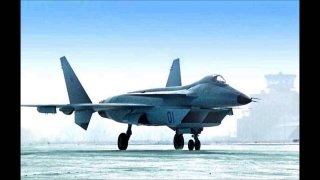Russia's MiG 1.44 Was No F-35 of F-22 (More Like a Failure)
Moscow tried to build a stealth fighter but it didn't spend enough to get the job done.
Here's What You Need to Remember: The MiG-1.44’s tortured birth and still more painful death is a sterling illustration of the inherent dangers of flagship military hardware development, where decades of expensive R&D work frequently amounts to nothing
Over the prior decade, Russia’s foray into fifth-generation jet fighter development has become synonymous with the upcoming Su-57. But the Su-57 was only Russia’s second attempt at developing a fifth-generation aircraft, preceded by several decades with an altogether different project.
This is the story of the ill-fated MiG 1.44.
In 1979, Soviet high command determined that a new generation of fighter aircraft was needed to ensure the competitiveness of the Soviet Air Force (VVS) into the 1990’s and beyond. The timing could not have been more apt; it was only several years later that the US air force began researching and developing what would become the highly capable F-22 fighter.
The project, which became known as MFI or “Multifunctional Frontline Fighter,” established a set of core design criteria roughly corresponding with the Soviet and early Russian understanding of what makes a fifth-generation fighter: supermaneuverability, supercruise capability (sustained supersonic speeds without the use of afterburners), low radar cross-section, integrated avionics system, and substantially improved landing/takeoff capability.
The procurement order went to Soviet aircraft manufacturer Mikoyan in 1983. After prolonged experimentation with several aerodynamic schemes, Mikoyan eventually settled on a duck-like delta wing design to distinguish their fighter from the forward-swept wing schemes of rival aircraft manufacturer Sukhoi. The Mikoyan-Sukhoi rivalry was among the reasons for MiG 1.44’s eventual failure, as Sukhoi continued to insist that their ongoing Su-37 project could deliver a better result at a lower cost.
At the end of a tortured research and development process, Mikoyan had cobbled together a VVS-approved prototype blueprint by 1991. The MiG 1.44’s final specifications remain shrouded in mystery, as almost all of the fighter’s known specifications are from the MFI stage of development. What is known, however, is that the MiG 1.44 was designed to be used with AL-41F engine, had a speed of approximately 1,500 km and range of up to 4,500 km, twelve internal and eight external hardpoints, and was compatible with almost the whole suite of Soviet Kh, KAB, and air-guided R-73/R-77 missiles. There is no reliable information as to the quality of the MiG-1.44’s “integrated” avionics and stealth capabilities, two of its most crucial design criteria.
As with many ambitious Soviet military projects of the 1980’s, the Soviet collapse imposed an unacceptable degree of strain on Mikoyan’s already tight budget. The newly formed Russian government shelved the MFI program after a brief testing period in 1994, citing cost concerns, and cancelled the program outright in 1997.
Not yet ready to admit defeat, Mikoyan managed to produce and test-fly a working MiG-1.44 prototype in 2000. The test flight revealed a slew of undisclosed performance deficiencies and engineering problems, leading the Kremlin to put the final nail in the MiG-1.44’s coffin. Russia’s fifth-generation fighter program had to be relaunched from the ground up with Sukhoi’s T-50 (now known as the Su-57) project, resulting in a massive sunk cost of fifteen years’ worth of research and development.
The MiG-1.44’s tortured birth and still more painful death is a sterling illustration of the inherent dangers of flagship military hardware development, where decades of expensive R&D work frequently amounts to nothing. But it can also be seen as a story of unrealized potential; had the Soviet military-industrial complex recommitted to the MFI program at an earlier stage, the MiG 1.44’s faults could perhaps have been revealed much sooner or avoided altogether.
Mark Episkopos is a frequent contributor to The National Interest and serves as research assistant at the Center for the National Interest. Mark is also a PhD student in History at American University. This article first appeared earlier in 2019 and is being republished due to reader interest.
Image: Reuters

